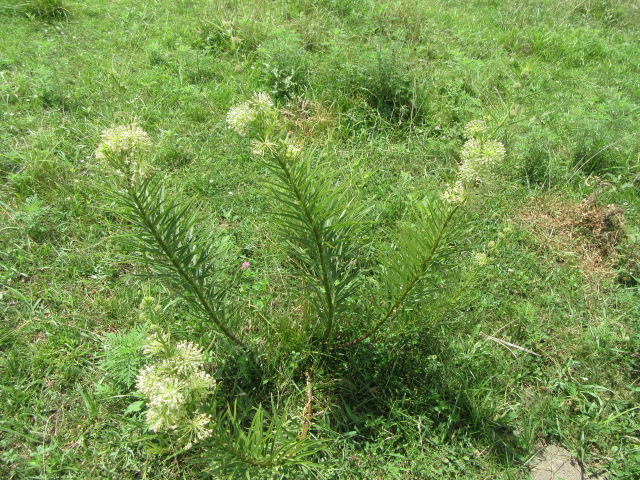
Asclepias stenophylla (Narrowleaf Milkweed) on 7-16-19. #602-1.
Hello everyone! I hope all is well with you. The past week has been fairly hot with no rain. I went back to check on the status of the thistles at Kevin’s farm north of town on Tuesday and Wednesday. I think I have them pretty well whipped but there are always a few I missed from before. The Bull Thistles are always a one-time shot and not that big of a problem. The Musk Thistles have been a different story. The bigger plants are all gone but small ones continue to sprout a flowering stem here and there. It is almost like they do this overnight. Supposedly they grow a rosette the first year and flower their second. Well, I can argue that point after spending two months with them. The plants that continue to shoot up flowers are less than a foot tall while earlier the bigger plants were up to around 4′ tall. It has really been an experience.
I have continued to take photos of wildflowers while I worked. There is a combination of two days of photographs in this post but I wanted them in alphabetical order. The Asclepias stenophylla (Narrowleaf Milkweed) in the above photo is getting with it now.
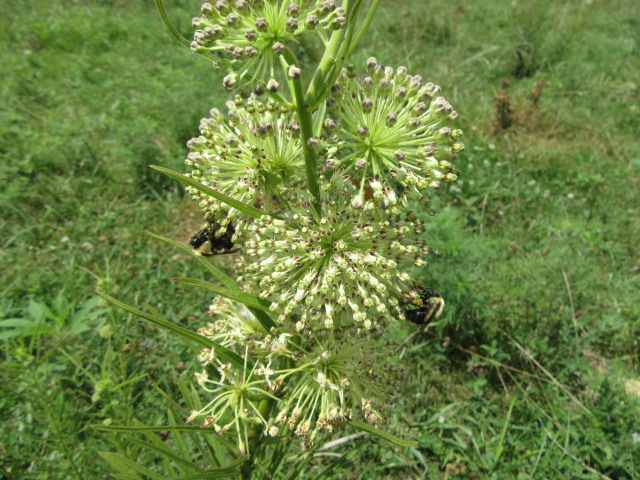
Asclepias stenophylla (Narrowleaf Milkweed) on 7-16-19, #602-2.
The bumblebees really like them.
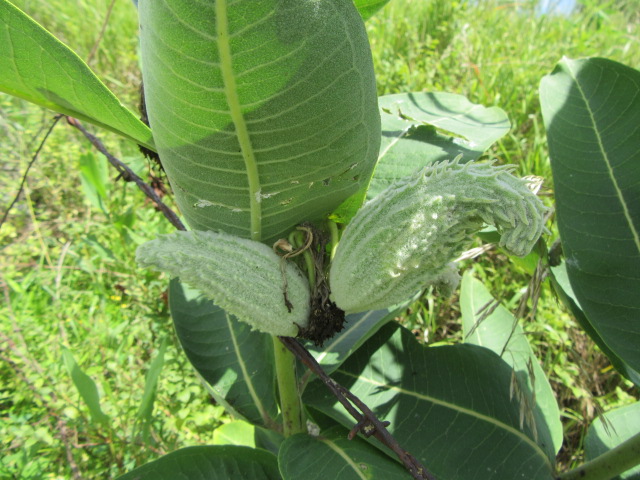
Asclepias syriaca (Common Milkweed) seed pod on 7-16-19, #602-4.
I had to take a photo of the seed pod of the Asclepias syriaca (Common Milkweed). Its unique seed pods are one of the identifying features of this species of milkweed.

Asclepias syriaca (Common Milkweed) on 7-16-19.
While taking photos, a cow walked by and ate the tops right off this Common Milkweed. You can see the sap oozing out of the stems… Hmmm…

Asclepias syriaca (Common Milkweed) on 7-16-19, # 602-6.
The Common Milkweed is a very robust plant that can grow to over 6′ tall. In pastures, they don’t get that chance and this group is only around 3′ tall, possibly multi-stemmed perhaps from an earlier pruning.

Asclepias viridis (Green Milkweed) seeds on 7-16-19, #602-7.
The Asclepias viridis (Green Milkweed) are among the first of the milkweeds to flower at the farm then are among the first to go to seed.

Asclepias viridis (Green Milkweed) seeds on 7-16-19, #602-8.
By contrast to many other plants, the large seed pods are mainly filled with fluff which helps the seeds float through the air. The distance they travel depends on a few things including wind speed and the height of neighboring plants. Rain can also spoil their trip by making the fluff heavy and wet and then the seeds just fall to the ground close to the parent plant.

Asclepias viridis on 7-17-19, #603-3.
While there are still a few Asclepias viridis (Green Milkweed) flowering, most have gone to seed.
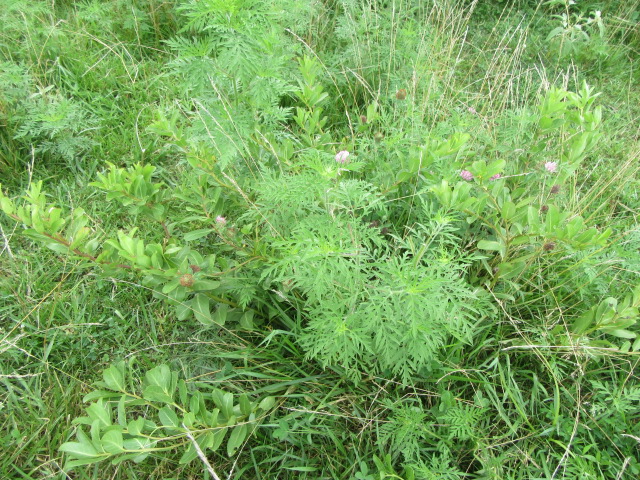
Asclepias sp. on 7-17-19, #603-1.
While most of the milkweeds are pretty easy to identify, especially when flowering, I have found one that has me stumped… When I first saw this plant and took a couple of photos, I didn’t realize what a difficult time I would have identifying it. If I had have known, I would have taken more photos and looked around for other plants like it while I was working.

Asclepias sp. on 7-17-19, #603-2.
If I have a plant I cannot figure out, I contact Pamela Trewatha from the Missouri State University (Springfield, Missouri). I am not sure if she is a botanist, horticulturalist or what but she maintains their Midwest Weeds and Wildflowers website and I think she took most of the photographs. She was stumped on this one as well which was very surprising. She thought it could be Asclepias sullivantii although she said she has never seen one in person. I looked at hundreds of photos online and I haven’t figured it out. This plant does not have the growth habit like Asclepias sullivantii nor are their leaves similar. There are many other differences as well that ruled out A. sullivantii. There were a few possibilities but not close enough. The one species that came close does not grow here and where it does grow it is very rare. There were no flowers on this plant and I didn’t notice any old flowers or seed pods. When I go back I will scout the area and see if there are other plants like this clump and possibly find flowers or seed pods. The spent flower in the above photo is a Red Clover…
There are several wildflower websites I use for ID. While there are milkweeds with similar leaves, some species leaves are “variable” and can be “oval” or have a slight point at the tip. However, the veining on this species leaves are not that “refined”, the tips are round, the midribs are light green (some species can have either maroonish or green midribs), and the central stems on this milkweed are brownish and not green like most… The leaves are also fairly small.

Cotinis nitida (Green June Beetle) on 7-16-19, #602-9.
I found a good-sized group of Bull Thistle I had somehow overlooked right in the middle of a large area. When I was getting ready to spray, the plants came to life as these HUGE beetles started flying out. It was very hot, so apparently, the beetles were farther down inside the thistles. I couldn’t get any photos at first because the beetles were moving pretty fast. Then, several feet away, I noticed this beetle along with a Japanese Beetle on a stem of an old Musk Thistle.

Cotinis nitida (Green June Beetle) on 7-16-19, #602-10.
The Cotinis nitida (Green June Beetle) is a pretty good-sized bug. They feed on flowers in pastures but also eat fruit. I attempted to pick up this guy (or gal) but it wanted no part of a new friendship. Beetles are not the most graceful flyers and sometimes you wonder if they even have a clue as to where they are going. These beetles sound like a small plane (very small) when they fly. When there are hundreds flying at once you might want to take cover because you will get run into.
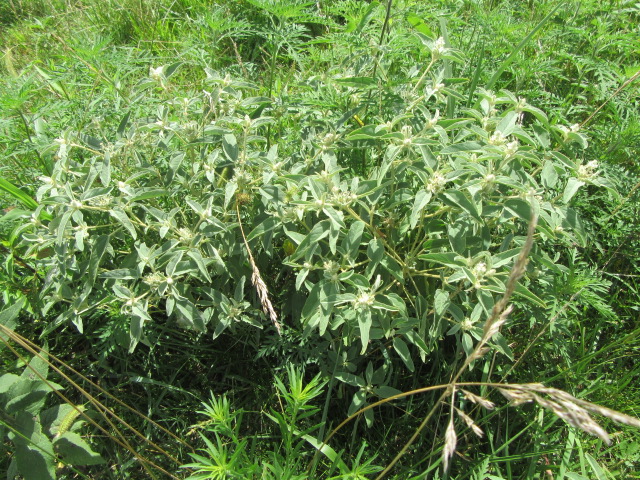
Croton capitatus (Hogwort) on 7-16-19, #602-11.
This interesting species is the Croton capitatus, commonly known as Hogwort, Wooly Croton, and Goatweed. Croton is a very large genus consisting of 1,173 species (as of this post date) and this species is found through much of the United States. The Missouri Department of Conservation says there are three species of Croton in Missouri. I have two species growing on the farm.

Croton capitatus (Hogwort) flowers on 7-16-19, #602-13.
Their flowers aren’t that particularly interesting unless you take a closer look… The cluster of flowers consists of male flowers toward the tip and female flowers below. Male flowers have 5 tiny white petals and 10-14 anthers. The female flowers don’t have petals but have 6-9 calyx lobes which are split 2-3 times making a total of 12-24 lobes. The fruits are about 1/4” wide and contain only three seeds each. Apparently doves and quail like their seeds.
While many wildflower species have many medicinal benefits, this plant produces Croton Oil which is a powerful laxative.

Dianthus armeria (Deptford Pink) on 7-17-19, #603-5.
The Dianthus armeria (Deptford Pink) grow throughout the farm here as well as at Kevin’s. The flowers are so small it is very hard to get good photos of, especially close-ups. The plants are very short and have narrow, lance-shaped leaves. Although not an original US native, they can be found growing throughout most of the US and Canada.

Dipsacus laciniatus (Cutleaf Teasel) on 7-16-19, #602-14.
While I was walking around the area where the Cutleaf Teasel (Dipsacus laciniatus) were I noticed more flowers. I guess the photos I had taken for a previous post were their buds and now they are flowering.
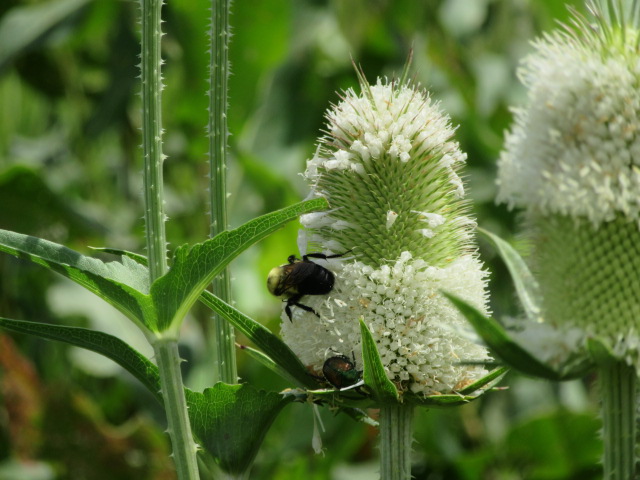
Dipsacus laciniatus (Cutleaf Teasel) flower on 7-16-19, #602-15.
There were a lot of bumblebees on the flowers as well as a few Japanese Beetles. It was funny watching for a few seconds. It was like the bumblebees were on a mission and no Japanese Beetles were going to get in their way.
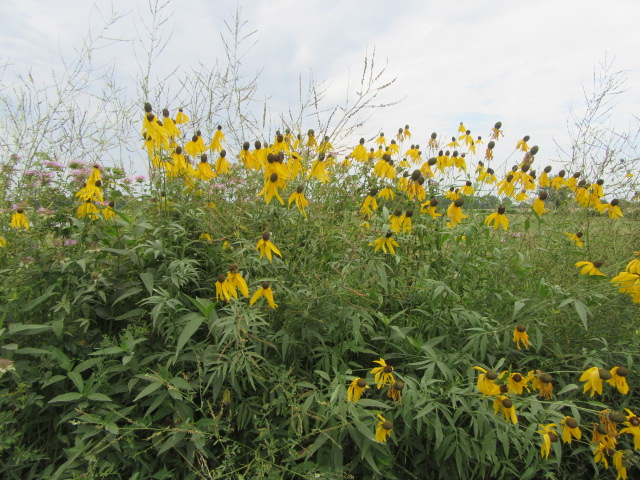
Echinacea paradoxa (Yellow Coneflower) on 7-17-19, #603-6.
I needed to go visit a friend Wednesday afternoon so I decided to drive by the large colony of Echinacea paradoxa (Yellow Coneflower). This is where I was going to dig some plants up this spring but… Well, it didn’t happen. Maybe I can collect some seeds later. I love the way the native coneflowers petals droop.
Ummm… While I was taking photos of the Yellow Coneflower, I noticed some really neat leaves but there were no flowers… Then later I spotted them again with flowers… The name begins with an “S” so it is farther down in the post. 🙂
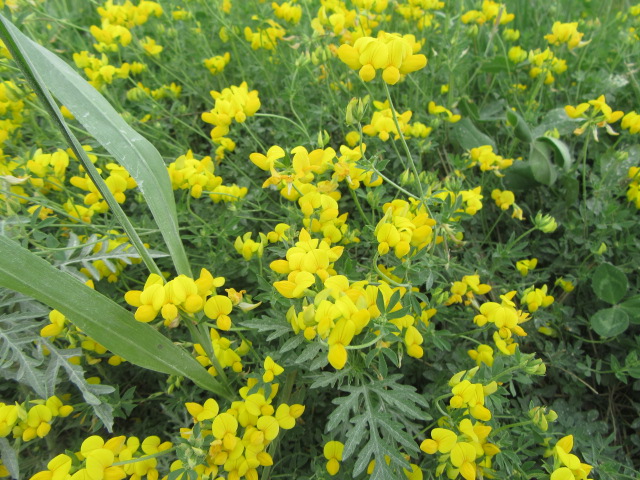
Lotus corniculatus (Bird’s Foot Trefoil) on 7-17-19, #603-7.
I have seen this plant growing along highways for MANY years and have always wondered with it was. Usually, I don’t have time or I don’t have the camera, but mainly because I didn’t want to stop along the highway. Well, when I went to visit my friend on Wednesday I noticed them growing along a different road. Not only them but the plants that begin with the “S”.
The plants in the above photo are Lotus corniculatus commonly known as the Bird’s Foot Trefoil. Hmmm… OK, I know how common the Bird’s Foot Trefoil is but I had never seen any up close and personal until now.
The Lotus corniculatus isn’t a US native. The Wikipedia says the plant is native to parts of North Africa and Eurasia. Hmmm… I learned something. I had to click on Eurasia to find out where it was. I don’t think they taught it was Eurasia when I was in school… It is the largest continent on Earth consisting of all of Europe and Asia with 70% of the world’s population. Hmmm… I didn’t even realize Africa was considered an Asian country. Well, I got stuck reading about Eurasia so I better get back to…
Where was I anyway? Oh yeah! Lotus corniculatus!
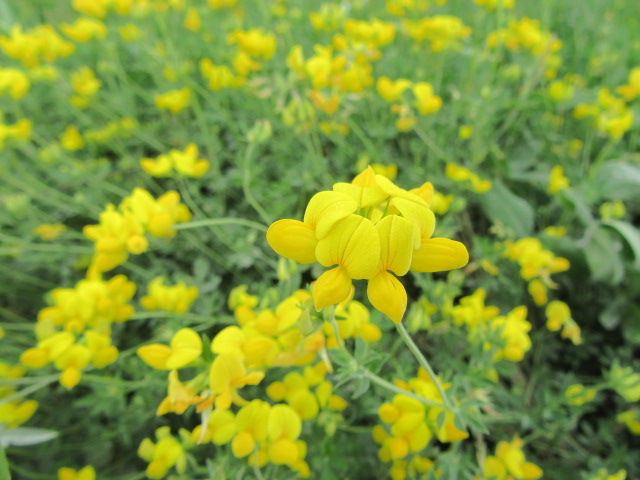
Lotus corniculatus (Bird’s Foot Trefoil) on 7-17-19, #603-8.
I lost my train of thought while reading about Eurasia and kind of went blank because I didn’t know… Anyway, it was interesting.
Bird’s Foot Trefoil is grown as a high-quality forage plant for pastures, hay, and silage that does not cause bloat.
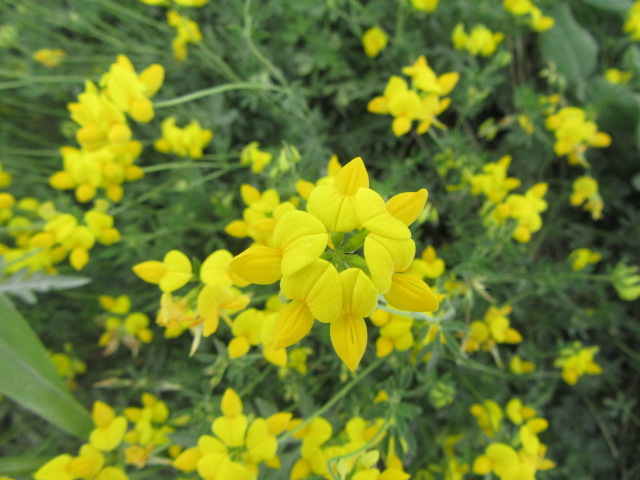
Lotus corniculatus (Bird’s Foot Trefoil) on 7-17-19, #603-9.
The flowers are particularly interesting. What is even more interesting is that a plant guy didn’t even realize these yellow flowers growing along the road were Bird’s Foot Trefoil! Several people have asked me what they were over the years but I never knew until now. Now I know and I am thankful. I am also thankful for learning where Eurasia is. 🙂
Ummm… The Lotus genus is a member of the Fabaceae (Pea Family) and contains 124 accepted species.
What we usually think of as a Lotus is the Nelumbo nucifera, also known as the Sacred Lotus Flower, Indian Lotus, Sacred Lotus, Bean of India, Egyptian Bean or simply lotus. It is the only genus in the family Nelumbonaceae with two accepted species. Strange the Water Lily isn’t in the same family, but they are in the Nymphaeaceae family. Hmmm…
I had to check on that because I was wondering why Bird’s Foot Trefoil was a Lotus. Then I find out the Lotus isn’t a Lotus. Double hmmm…

Maclura pomifera (Osage Orange) on 7-16-19, #602-16.
OK, I realize the Maclura pomifera (Osage Orange) isn’t a wildflower and maybe most wouldn’t find them that interesting. For me, though, I think they are a magnificent tree especially when they get very old.

Maclura pomifera (Osage Orange), 7-16-19, #602-17.
Just look at that massive trunk… This tree isn’t quite as large as the old one at my place, but it is still pretty good sized.

Maclura pomifera (Osage Orange) on 7-16-19, #602-21.
This tree, like most very old Osage Orange, have stood the test of time. Just think of how many high winds, thunderstorms, heavy snows, and ice they have been through. If you ever have a chance to visit a very old and large Osage Orange, look up into the tree and you can see how they have twisted and turned over the years. They tell a tale of a long life in the elements of nature and have endured them all. This tree was really talking and I enjoyed our brief visit and feeling the energy surrounding it. It is more than alive, it is A LIFE! 🙂
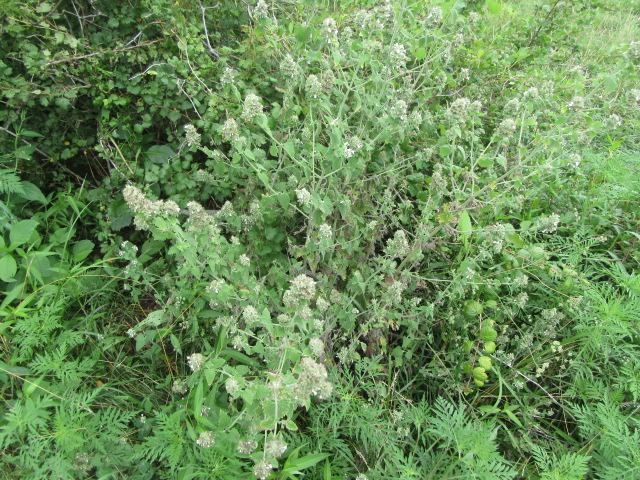
Nepeta cataria (Catnip) on 7-17-19, #603-10.
While I was spraying in a little area I had rarely gone, I noticed a plant I completely didn’t expect to see in the wild. I said, “It’s a mint! What in the world are you doing here?” Of all places next to a Gooseberry bush and Osage Orange tree where an old fence row had been. Just goes to show you just never know what you might find… Oh! It is a Nepeta cataria… Catnip! They have different leaves and flowers than Spearmint.
I suppose the Catnip has to grow in the wild somewhere and there are several mints that are native to Missouri. I have just never seen any in the wild. Of course, they are members of the Lamiaceae family along with 234 other genera of aromatic and tasty culinary herbs.

Physalis longifolia (Common or Smooth Ground Cherry) flower on 7-16-19, #602-22.
Had I not noticed something weird about this plant, I could have easily passed it off as a Horsenettle. All I saw at first was a nearly hidden yellow flower drooping downward so I thought I would have a peek because Horsenettle does not have yellow flowers. Then I saw what else was hidden beneath the leaves. As it turns out this plant is a Physalis longifolia, commonly known as the Common or Smooth Ground Cherry.

Physalis longifolia (Common or Smooth Ground Cherry) flower, on 7-16-19, #602-23.
AH HA, you say! 🙂 Well, at least I thought it looks like the plant called Chinese Lantern, which is actually Physalis peruviana. Perhaps you were thinking about the Tomatillo or Mexican Husk Tomato which is the Physalis philadelphica and/or Physalis ixocarpa. Well, inside of these small lanterns is a fruit which is also edible…

Ruellia humilis (Wild Petunia) on 7-16-19, #602-24.
The Ruellia humilis (Wild Petunia, etc.) are growing here and there on Kevin’s farm as where I live. They seem to be growing as solitary plants rather than in colonies except for in my ditch where there are several. I think there are more in the ditch in front of the house than on the entire pasture and hayfield. While they flower over a long period, they seem to only produce one flower at a time. While one bud is beginning to open, the one before it is fading. Some information online says the flowers open in the morning and fall off in the evening. Hmmm… These plants are very easy to recognize in the wild because, after all, they are a petunia. Not saying all Ruellia species are the same, but all do have similar characteristics. Plants of the World Online currently list 357 accepted species in the genus.
Now that I am down to the mystery plant… Well, maybe I should save it for a post of its own. Just kidding. 🙂 But I do feel a nap coming on…

Silphium laciniatum (Compass Plant) leaves on 7-17-19, #603-13.
OK… The above photo, although taken out of numerical order, is the leaves of the plant with no flowers I saw when photographing the Echinacea paradoxa. They were by the road so apparently, their flower stems had been mowed off. I took the photo because I thought they were quite strange and unusual.

Silphium laciniatum (Compass Plant) on 7-17-19. #603-20.
Hmmm… I realize you are laughing at me AGAIN because anyone who has driven on most highways and backroads has seen this plant. Of course, like me, maybe you just passed them off as some kind of sunflower. I had no idea this plant had so much interest whatsoever.
Found throughout Missouri except for the southeast corner, the Silphium laciniatum is easily identified by its pinnatifid leaves, hairy stems, and big yellow flower heads. Its common name is the Compass Plant because their flowerheads follow the sun across the sky (heliotropism) like many species in the Asteraceae family such as sunflowers.

Silphium laciniatum (Compass Plant) leaves on 7-17-19, #603-14.
Silphium laciniatum has been used as a worm expelling, coughs, lung problems, asthma, and as an emetic. The resin produced on the upper part of the stems was chewed by Native Americans. The mouth cleansing gum is said to be fragrant but bitter.
Contrary to what you might think, the common name comes from their leaves and not their flowers. Pioneers believed that the leaves of the Compass Plant pointed in a north-south direction. The basal leaves do usually grow on a north-south axis thought to minimize intense overhead sun exposure. Of course, their flowers follow an east to west movement following the sun…

Silphium laciniatum (Compass Plant) flower on 7-17-19, #603-23.
The Compass Plant grow from 6-12 feet tall and their flowers can be up to 5″ across. It can take several years for these plants to develop into a full-sized plant but they can live up to 100 YEARS! Their taproots can grow 15′ deep! The basal leaves can grow to 18″ long while the upper leaves are much smaller.
So now we know these plants are Compass Plants and not just another sunflower. 🙂
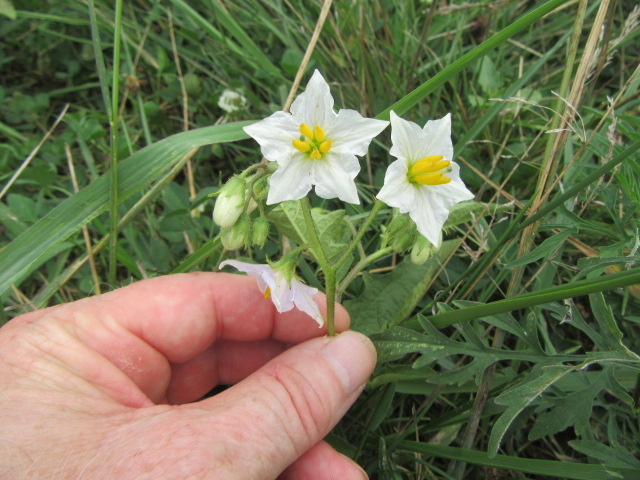
Solanum carolinense (Horsenettle) on 7-17-19, #603-25.
Of course, this is the common ‘ol run of the mill Horsenettle (Solanum carolinense) we may all love to hate. One of its common names, Tread Softly, says a lot! While it is a member of the Nightshade family (along with tomatoes) and its fruit may look like cherry tomatoes, DO NOT EAT! The Wikipedia says:
“All parts of the plant, including its tomato-like fruit, are poisonous to varying degrees due to the presence of solanine glycoalkaloids which is a toxic alkaloid and one of the plant’s natural defenses. While ingesting any part of the plant can cause fever, headache, scratchy throat, nausea, vomiting, and diarrhea, ingesting the fruit can cause abdominal pain, circulatory and respiratory depression, or even death. “
I may have not taken a photo of the Horsenettle if it weren’t for the flower below which I noticed the day before…
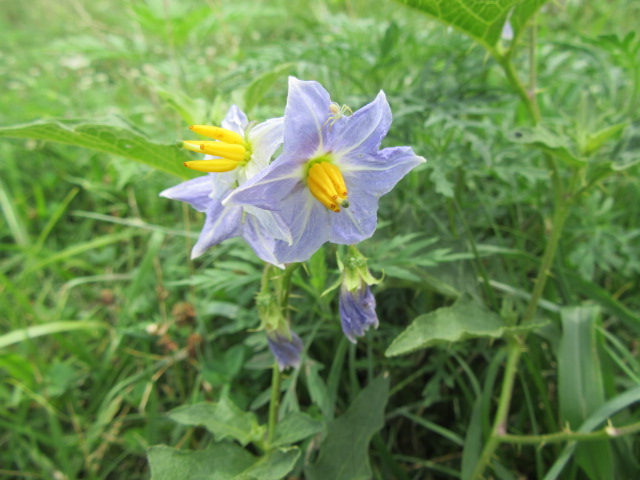
Solanum carolinense (Horsenettle) on 7-16-19, #602-25.
Ummm… As I was working I noticed something a little unusual… While I do have a lot of Horsenettle in my pastures and hayfield, some of the colonies in Kevin’s pasture have these blue flowers. While it is true that some in my pasture do have a slight tint, they are mainly all white. So, I took photos and found that these are also Solanum carolinense. I thought maybe they were a different species, but no, just a different shade.

Verbena stricta (Hoary Vervain) on 7-16-19, #602-29.
One of my favorite wildflowers is Verbena. The interesting thing is that the species growing on Kevin’s farm are different than the ones growing where I live. This one is Verbena stricta commonly known as the Hoary Vervain. The species growing in my pastures and hayfield is the Verbena hastata commonly known as the Blue Vervain. I mainly noticed the difference by the Verbena stricta‘s broader leaves and larger flowers. The one thing that makes them very similar is getting photos that aren’t blurry… While Plants of the World Online list 147 species in the Verbena genus native to most parts of the world, Verbena hastata and Verbena stricta are native to most of the US and Canada.
I am finished for now because I ran out of photos. 🙂 I thoroughly enjoyed this post because I learned A LOT. I am thankful I found out about Eurasia, too!
Until next time, be safe, stay positive, and always, always, be thankful! After a week of heat and no rain, I am thankful we finally had rain this morning and as I am finishing this post.
A lovely & interesting tour, so much to discover in that field. I like that the cow thought ‘what is he looking at?’ & came & ate your subject! So great to find the physalis lanterns too & As always where you are, huge beetles! I’m getting better with larger insects as I get older & I happily escorted a stag beetle from the hall the other week but when you talk about loads of beetles this size …. I’m not so sure 🤨
LikeLiked by 1 person
Hello Debbie! I think it is neat how there are different species at Kevin’s than where I live. Always something to discover. Can you imagine if the Stag Beetles swarmed and got in your house? What if they liked hibernating inside your curtains like Lady Beetles do sometimes. 🙂 I am going to check on the strange milkweed today. Take care and thanks for the comment!
LikeLike
I was hoping for an A to Z but an A to V is pretty good!
LikeLike
Hello Tommy! I kind of fell short of the whole alphabet, huh? Thanks for the comment!
LikeLike
I LOL about the cow eating your subject. This is a great post, I love wildflowers always have, I especially love the Verbena stricta, I love that color. I also like all the yellow ones, well I just like all of them. 🙂 Your love for nature comes through in all of your posts. Thanks for the tour of these gorgeous wild flowers.
LikeLike
Hello Masha! I have enjoyed being with nature while working and taking photos of different plants. The cows have eaten plants I have been watching more than a few times. 🙂 That is just part of the circle of life even though it can be a bit irritating. I am thankful I saw the plant in the first place. Nature comes in a wide mix of colors and is always happy to share. Nature is amazing and I always do my best to share with others with the photos. You are welcome for the tour and thanks for the comment!
LikeLike
Lots of lovely plants there. We have birds foot trefoil growing here where it is native. If you see it going to seed you will understand the common name!
LikeLiked by 1 person
Hello Nancy! I will be watching for the seed. Thanks for the comment!
LikeLike
Milkweed! That’s what keeps plugging up my air-conditioning unit outside! I have to hose it off every few days…lol
LikeLiked by 1 person
Hello Diane! That is good you have milkweed. 🙂 Thanks for the comment!
LikeLike
The milkweeds in my small patch by the rain barrel are taller than me now. Monarchs are often in them.
On my walks I often pass a patch of horse nettle. I took a close up picture of one for a drawing exercise last summer. I like their 5 pointed stars.
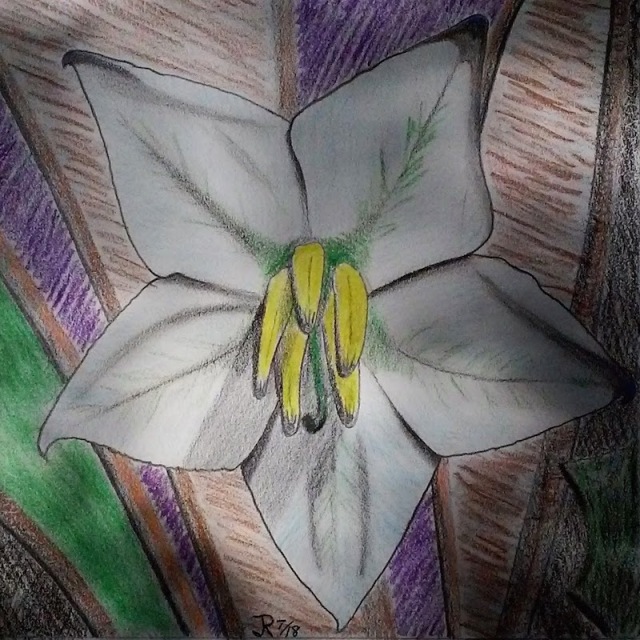
LikeLiked by 1 person
Hello Jim! Glad to hear your milkweeds are doing well. What is their name? Your Horsenettle drawing looks very good! Thanks for the comment!
LikeLike
One is the common milkweed. I don’t know the other.
LikeLiked by 1 person
Ahhh… The Common Milkweed are AWESOME! So, tell me, as the seeds disperse do you have a problem with them coming up in your yard?
LikeLike
No. The existing milkweeds send out underground runners and pop up nearby. I pull those to keep them from encroaching too far.
LikeLiked by 1 person
Ahhhh…
LikeLike
I love this post. Many of the same wildflowers exist in our pecan orchard. Thanks for cluing me in to some species that had remained unidentified! I’m always happy to learn something new.
LikeLiked by 1 person
Hello Laura! Glad you enjoyed the post and it helped ID a few of your wildflowers. Finding and identifying new wildflowers is like meeting new people. We are all a little different but alike in many ways. Thanks for the comment!
LikeLiked by 1 person